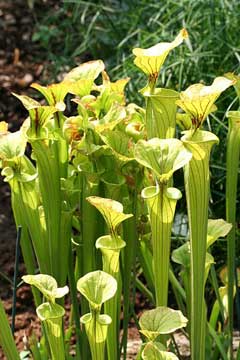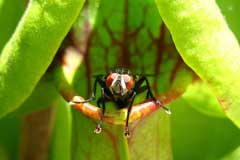 |
|
http://commons.wikimedia.org/wiki/User:Jean-Pol_GRANDMONT |
 |
| http://commons.wikimedia.org/wiki/User:Ste3986 |
Translate this page:
Summary
Bloom Color: Yellow. Main Bloom Time: Early summer, Late summer, Late spring, Mid summer. Form: Upright or erect.
Physical Characteristics

 Sarracenia flava is a PERENNIAL growing to 0.5 m (1ft 8in) by 0.5 m (1ft 8in) at a fast rate.
Sarracenia flava is a PERENNIAL growing to 0.5 m (1ft 8in) by 0.5 m (1ft 8in) at a fast rate.
See above for USDA hardiness. It is hardy to UK zone 7. It is in flower from April to May. The species is hermaphrodite (has both male and female organs).
Suitable for: light (sandy), medium (loamy) and heavy (clay) soils. Suitable pH: mildly acid, neutral and basic (mildly alkaline) soils and can grow in very acid soils.
It can grow in semi-shade (light woodland) or no shade. It prefers wet soil.
UK Hardiness Map
US Hardiness Map
Synonyms
Plant Habitats
Woodland Garden Sunny Edge; Dappled Shade; Shady Edge; Bog Garden;
Edible Uses
References More on Edible Uses
Medicinal Uses
Plants For A Future can not take any responsibility for any adverse effects from the use of plants. Always seek advice from a professional before using a plant medicinally.
Hepatic Kidney
The root and leaves are hepatic. They are used in the treatment of dyspepsia, constipation, liver and kidney complaints[61].
References More on Medicinal Uses
The Bookshop: Edible Plant Books
Our Latest books on Perennial Plants For Food Forests and Permaculture Gardens in paperback or digital formats.

Edible Tropical Plants
Food Forest Plants for Hotter Conditions: 250+ Plants For Tropical Food Forests & Permaculture Gardens.
More

Edible Temperate Plants
Plants for Your Food Forest: 500 Plants for Temperate Food Forests & Permaculture Gardens.
More

More Books
PFAF have eight books available in paperback and digital formats. Browse the shop for more information.
Shop Now
Other Uses
References More on Other Uses
Cultivation details
Landscape Uses:Container, Specimen, Woodland garden. Grow in sun or partial shade in peat or moss[188]. An insectivorous plant[61], it is best grown in a boggy position[1] and prefers a soil low in nitrogen. Plants require continuously moist conditions in a loose compost of sphagnum peat, live sphagnum and coarse acid sand[260]. They can be grown successfully in a plastic basin or in a pot that is standing in a deep saucer of water[260]. Plants are not hardy in Britain, requiring a minimum temperature of 5°c[188]. This conflicts with the hardiness rating of 7 (temperatures down to between -5 and -10°c) given in [200]. Plants can tolerate temperatures down to about -10°c[260]. A polymorphic species[200], it is becoming very rare in the wild and is on the CITES II list of endangered species. Special Features:
Attractive foliage, North American native, Naturalizing.
References Carbon Farming Information and Carbon Sequestration Information
Temperature Converter
Type a value in the Celsius field to convert the value to Fahrenheit:
Fahrenheit:
The PFAF Bookshop
Plants For A Future have a number of books available in paperback and digital form. Book titles include Edible Plants, Edible Perennials, Edible Trees,Edible Shrubs, Woodland Gardening, and Temperate Food Forest Plants. Our new book is Food Forest Plants For Hotter Conditions (Tropical and Sub-Tropical).
Shop Now
Plant Propagation
Seed - we have no information for this species but would suggest sowing the seed in light shade in a cold frame as soon as it is ripe if possible otherwise in early spring. When they are large enough to handle, prick the seedlings out into individual pots and grow them on in the greenhouse for at least their first winter. Plant them out into their permanent positions in late spring or early summer, after the last expected frosts. Consider giving the plants some protection from the cold for their first winter outdoors. Division might be possible.
Other Names
If available other names are mentioned here
Native Range
NORTHERN AMERICA: United States (Alabama (south), Florida, Georgia (south & central), North Carolina, South Carolina, Virginia (southeast))
Weed Potential
Right plant wrong place. We are currently updating this section.
Please note that a plant may be invasive in one area but may not in your area so it's worth checking.
Conservation Status
IUCN Red List of Threatened Plants Status :

Growth: S = slow M = medium F = fast. Soil: L = light (sandy) M = medium H = heavy (clay). pH: A = acid N = neutral B = basic (alkaline). Shade: F = full shade S = semi-shade N = no shade. Moisture: D = dry M = Moist We = wet Wa = water.
Now available:
Food Forest Plants for Mediterranean Conditions
350+ Perennial Plants For Mediterranean and Drier Food Forests and Permaculture Gardens.
[Paperback and eBook]
This is the third in Plants For A Future's series of plant guides for food forests tailored to
specific climate zones. Following volumes on temperate and tropical ecosystems, this book focuses
on species suited to Mediterranean conditions—regions with hot, dry summers and cool, wet winters,
often facing the added challenge of climate change.
Read More
Expert comment
Author
L.
Botanical References
43200
Links / References
For a list of references used on this page please go here
Readers comment
| Add a comment |
|
If you have important information about this plant that may help other users please add a comment or link below. Only comments or links that are felt to be directly relevant to a plant will be included. If you think a comment/link or information contained on this page is inaccurate or misleading we would welcome your feedback at [email protected]. If you have questions about a plant please use the Forum on this website as we do not have the resources to answer questions ourselves.
* Please note: the comments by website users are not necessarily those held by PFAF and may give misleading or inaccurate information.
To leave a comment please Register or login here All comments need to be approved so will not appear immediately.
|
Subject : Sarracenia flava
|
|
|
|